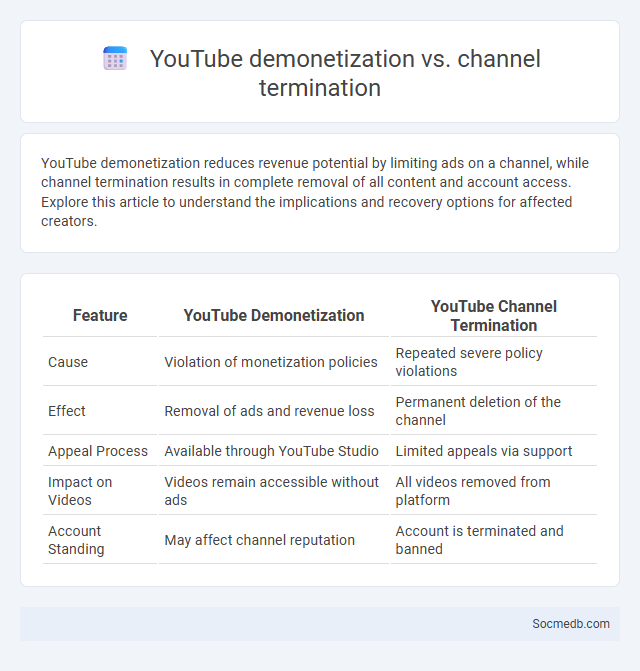
Photo illustration: YouTube demonetization vs channel termination
YouTube demonetization reduces revenue potential by limiting ads on a channel, while channel termination results in complete removal of all content and account access. Explore this article to understand the implications and recovery options for affected creators.
Table of Comparison
| Feature | YouTube Demonetization | YouTube Channel Termination |
|---|---|---|
| Cause | Violation of monetization policies | Repeated severe policy violations |
| Effect | Removal of ads and revenue loss | Permanent deletion of the channel |
| Appeal Process | Available through YouTube Studio | Limited appeals via support |
| Impact on Videos | Videos remain accessible without ads | All videos removed from platform |
| Account Standing | May affect channel reputation | Account is terminated and banned |
Understanding YouTube Demonetization: What It Means
YouTube demonetization refers to the platform's practice of restricting or removing ad revenue from videos that violate its advertiser-friendly guidelines, impacting creators' earnings. Understanding the specific content policies, such as restrictions on violence, hate speech, or controversial topics, helps you navigate and maintain monetization status effectively. Monitoring your content's compliance and audience engagement metrics is crucial for sustaining YouTube monetization and maximizing your channel's revenue potential.
Channel Termination Explained: Causes and Consequences
Channel termination in social media occurs when platforms or users discontinue access due to policy violations, inactivity, or security concerns. This action results in loss of content, reduced audience engagement, and potential damage to your brand reputation. Understanding the causes and consequences helps you maintain compliance and sustain effective online presence.
Demonetization vs Channel Termination: Key Differences
Demonetization refers to the removal of a channel's ability to earn revenue through ads, while channel termination involves the complete deletion or suspension of the channel by the platform. Demonetization affects only monetization features, often due to policy violations or inappropriate content, whereas termination results from severe or repeated breaches, leading to loss of access and content removal. Understanding these distinctions is crucial for content creators aiming to maintain compliance and sustain their presence on social media platforms.
YouTube’s Community Guidelines and Monetization Policies
YouTube's Community Guidelines enforce strict rules against harmful content such as hate speech, misinformation, and harassment to maintain a safe platform environment. Monetization policies require creators to follow advertiser-friendly content standards, including restrictions on controversial topics, copyrighted material, and explicit content. Adherence to these guidelines directly impacts eligibility for monetization and channel growth within YouTube's ecosystem.
Common Reasons for YouTube Demonetization
YouTube demonetization commonly occurs due to violations of community guidelines, copyrighted content, or inappropriate language and imagery in videos. Your channel's revenue can be impacted if ads are deemed unsuitable for certain content categories or if there is inconsistent viewer engagement and watch time. Ensuring compliance with YouTube's advertiser-friendly policies is crucial to maintaining monetization status and maximizing earnings.
Factors Leading to Channel Termination
Rapid changes in social media policies, repeated violations of community guidelines, and prolonged inactivity are primary factors leading to channel termination. You must adhere strictly to platform rules regarding content, copyright, and user interaction to avoid penalties. Enforcement mechanisms often include automated detection systems and user reports, which can result in immediate or gradual removal of channels.
How to Avoid Demonetization on YouTube
To avoid demonetization on YouTube, ensure your content adheres strictly to the platform's Community Guidelines and Advertiser-Friendly Content policies by avoiding sensitive topics such as hate speech, violence, and inappropriate language. You should consistently create original, high-quality videos that engage your audience while staying away from copyrighted material that can trigger restrictions. Regularly reviewing YouTube's policy updates helps you stay compliant and protect your channel's monetization status.
Steps to Appeal Demonetization or Termination
To appeal demonetization or termination on social media platforms, first review the platform's specific policies and guidelines to understand the reason for the action. Submit a formal appeal through the designated online form or help center, providing clear evidence or explanations supporting your case. Monitor the appeal status regularly and be prepared to provide additional information if requested by the platform's support team.
Impact of Demonetization on Creators’ Revenue
Demonetization policies on social media platforms have significantly impacted creators' revenue streams by reducing or restricting ad placements on content deemed unsuitable by automated systems. Many creators experience a sharp decline in income due to inadequate transparency, inconsistent enforcement, and the algorithms' inability to accurately assess nuanced content. This financial instability forces creators to diversify income through sponsorships and crowdfunding to sustain their digital presence.
Future of Content Creation: Navigating YouTube’s Monetization Rules
Navigating YouTube's evolving monetization rules requires content creators to prioritize authentic engagement and comply with community guidelines to sustain revenue streams. Emerging trends indicate an increasing emphasis on originality, viewer retention, and diversified income sources like Super Chats and channel memberships. Staying informed on policy updates and adapting content strategies ensures creators maximize earnings in a competitive digital landscape.
 socmedb.com
socmedb.com